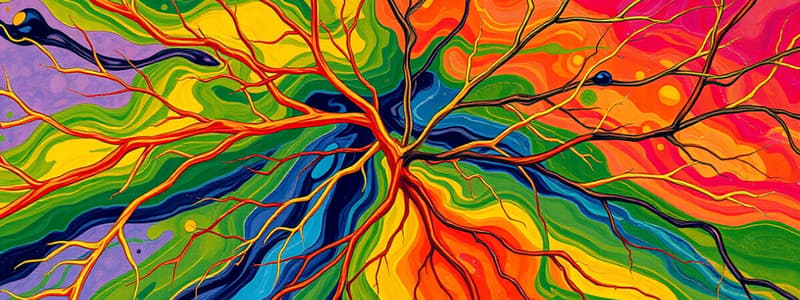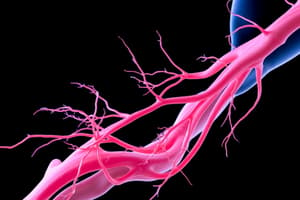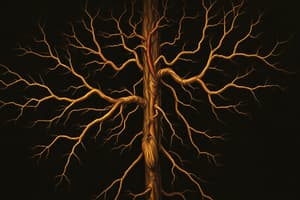Podcast
Questions and Answers
What does PNS stand for?
What does PNS stand for?
- Primary Nerve System
- Peripheral Nervous System (correct)
- Prolonged Nervous System
- Pulling Nerve System
What are the components of the PNS?
What are the components of the PNS?
Nerves, ganglia, enteric plexuses, and sensory receptors.
What are ganglia?
What are ganglia?
Small masses of nervous tissue, primarily consisting of neuron cell bodies, located outside of the brain and spinal cord.
What are enteric plexuses?
What are enteric plexuses?
What does SNS consist of?
What does SNS consist of?
What does ANS consist of?
What does ANS consist of?
What are the two divisions of the motor part of the ANS?
What are the two divisions of the motor part of the ANS?
Neurons undergo mitotic division.
Neurons undergo mitotic division.
What is the difference between neuroglia and neurons?
What is the difference between neuroglia and neurons?
What does the neuron cell body contain?
What does the neuron cell body contain?
What are Nissl bodies?
What are Nissl bodies?
What is the function of newly synthesized proteins produced by Nissl bodies?
What is the function of newly synthesized proteins produced by Nissl bodies?
What does the cytoskeleton include?
What does the cytoskeleton include?
What is lipofuscin?
What is lipofuscin?
What is the general term for any neuronal process that emerges from the cell body?
What is the general term for any neuronal process that emerges from the cell body?
What is the axon hillock?
What is the axon hillock?
What is the initial segment of the axon?
What is the initial segment of the axon?
What is the trigger zone?
What is the trigger zone?
What does the axon contain?
What does the axon contain?
What does the dendrite cytoplasm contain?
What does the dendrite cytoplasm contain?
What is axoplasm?
What is axoplasm?
What is the axolemma?
What is the axolemma?
What are axon collaterals?
What are axon collaterals?
What are synaptic end bulbs?
What are synaptic end bulbs?
What are varicosities?
What are varicosities?
What stores neurotransmitters?
What stores neurotransmitters?
What is slow axonal transport?
What is slow axonal transport?
What is fast axonal transport?
What is fast axonal transport?
What is anterograde transport?
What is anterograde transport?
What is retrograde transport?
What is retrograde transport?
What are multipolar neurons?
What are multipolar neurons?
What are bipolar neurons?
What are bipolar neurons?
What are unipolar neurons?
What are unipolar neurons?
Where is the trigger zone for nerve impulses in a unipolar neuron?
Where is the trigger zone for nerve impulses in a unipolar neuron?
What are Purkinje cells?
What are Purkinje cells?
What are pyramidal cells?
What are pyramidal cells?
What are the functional classifications of neurons?
What are the functional classifications of neurons?
What are gliomas?
What are gliomas?
What neuroglia are found in the CNS?
What neuroglia are found in the CNS?
What neuroglia are found in the PNS?
What neuroglia are found in the PNS?
What are the functions of astrocytes?
What are the functions of astrocytes?
What are protoplasmic astrocytes?
What are protoplasmic astrocytes?
What are fibrous astrocytes?
What are fibrous astrocytes?
What do the processes of astrocytes contact?
What do the processes of astrocytes contact?
What is the role of oligodendrocytes?
What is the role of oligodendrocytes?
What do microglial cells function as?
What do microglial cells function as?
Where are ependymal cells located?
Where are ependymal cells located?
What do ependymal cells produce?
What do ependymal cells produce?
What are Schwann cells responsible for?
What are Schwann cells responsible for?
What does each Schwann cell myelinate?
What does each Schwann cell myelinate?
What are satellite cells?
What are satellite cells?
What two types of neuroglia produce myelin sheaths?
What two types of neuroglia produce myelin sheaths?
What is neurolemma?
What is neurolemma?
How does the neurolemma aid regeneration when an axon is injured?
How does the neurolemma aid regeneration when an axon is injured?
What are nodes of Ranvier?
What are nodes of Ranvier?
What is a tract?
What is a tract?
What is white matter composed of?
What is white matter composed of?
What does grey matter contain?
What does grey matter contain?
Flashcards are hidden until you start studying
Study Notes
Peripheral Nervous System (PNS)
- PNS includes all nervous tissue outside the central nervous system (CNS).
- It is categorized into three divisions: Somatic Nervous System (SNS), Autonomic Nervous System (ANS), and Enteric Nervous System (ENS).
Components of the PNS
- Major components are nerves, ganglia, enteric plexuses, and sensory receptors.
Ganglia
- Small clusters of neuron cell bodies situated outside the brain and spinal cord.
Enteric Plexuses
- Networks of neurons located within the gastrointestinal tract, aiding in digestive regulation.
Somatic Nervous System (SNS)
- Composed of sensory neurons that transmit information from somatic receptors to the CNS and motor neurons that direct voluntary movement to skeletal muscles.
Autonomic Nervous System (ANS)
- Contains sensory neurons that relay information from autonomic sensory receptors; motor neurons control involuntary actions in smooth muscle, cardiac muscle, and glands.
Sensory Neurons of the ENS
- Monitor chemical changes and stretching in the GI tract, regulating contractions and secretions for digestion.
Neuroglia vs. Neurons
- Neuroglia are smaller but significantly outnumber neurons, providing support and protection. Unlike neurons, they can divide throughout life.
Neuron Structure
- Neuron cell bodies house a nucleus, cytoplasm, and organelles like lysosomes and mitochondria.
- Nissl bodies are clusters of ribosomes and rough endoplasmic reticulum in the cell bodies, involved in protein synthesis.
Neuron Processes
- Axon hillock is where the axon joins the cell body, serving as a critical site for impulse generation.
- Axons can have collaterals, which are side branches, and they terminate in synaptic end bulbs or varicosities that store neurotransmitters.
Axonal Transport
- Slow axonal transport moves materials from the cell body towards axon terminals at a rate of 1-5 mm/day.
- Fast axonal transport can move materials at speeds of 200-400 mm/day and occurs in both anterograde (cell body to axon terminal) and retrograde (axon terminal to cell body) directions.
Neuron Types
- Multipolar neurons possess multiple dendrites and an axon, mostly found in the CNS.
- Bipolar neurons have one axon and one main dendrite, located in sensory structures such as the retina.
- Unipolar neurons have fused dendrites and an axon; their trigger zone is where dendrites meet the axon.
Glial Cells
- Gliomas are tumors originating from glial cells.
- CNS glial cells include astrocytes, oligodendrocytes, microglia, and ependymal cells.
- PNS glial cells consist of Schwann and satellite cells.
Astrocytes
- Largest glial cells with star-like shapes, they create a blood-brain barrier to protect neurons and maintain the chemical environment.
Oligodendrocytes
- Form and maintain the myelin sheath around CNS axons; crucial for insulating and speeding up neural impulses.
Microglial Cells
- Act as immune defense in the CNS, removing debris and responding to injury.
Ependymal Cells
- Line the brain's ventricles and the central canal of the spinal cord, involved in cerebrospinal fluid production and circulation.
Schwann Cells
- Form myelin sheaths around PNS axons and facilitate regeneration after nerve injury.
Nodes of Ranvier
- Gaps in the myelin sheath crucial for the rapid conduction of nerve impulses.
CNS vs. PNS Structure
- White matter is primarily composed of myelinated axons, while gray matter consists of neuronal cell bodies and unmyelinated axons, giving it a grayish appearance due to the presence of Nissl bodies.
Studying That Suits You
Use AI to generate personalized quizzes and flashcards to suit your learning preferences.




